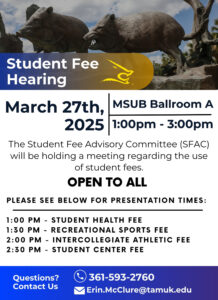Low-enrollment programs could be in danger
Texas A&M University Kingsville (TAMUK) has had a steady decline in student enrollment over the last few years. In Fall 2018, TAMUK had 6,916 undergraduate students enrolled at the university. This semester, 5,075 undergraduate students are currently enrolled, according to figures released by the university.
Though the decline fluctuates year to year, the trend plaguing the university is relevant and exists. For example, in Fall 2019 TAMUK hosted 2,122 freshmen. The class estimated to graduate in 2023 now consists of 990 junior students. A 53.3 percent decrease in the overall class.
Though undergraduate enrollment is low there has been an increase in international graduate student enrollment and an increase of students living on campus. However, programs with the lowest enrollment could also face future cuts, officials said.
“The campus community must work to reverse the current enrollment trends, so that decline in enrollment does not impact future operating budgets,” TAMUK President Mark Hussey said. “We are currently evaluating low-enrollment, less popular majors, and if enrollment continues to decline, we will have to make decisions about these programs moving forward.”
To combat this issue the university has combined Enrollment Management and Student Affairs into one division, Enrollment Services and Student Affairs, and has hired new staff to lead.
“Enrollment and retention are of the utmost importance and it requires an all-hands-on-deck approach,” Vice President of Enrollment Services and Student Affairs Dr. Rito Silva said. “The Enrollment Management team, together with faculty and staff from across campus, are working together to reach out to prospective students in a number of ways. Texas A&M-Kingsville provides students with a comprehensive college experience, an excellent education and a strong sense of community. Once students know what Texas A&M-Kingsville can provide we are confident that many will recognize the tremendous value we offer.”
One way TAMUK plans on increasing enrollment is through rebuilding relationships with schools throughout South Texas, relationships which suffered because of the pandemic.
“Since I began in this role on June 1, we are doing more outreach to the schools, prospective students and their families in our region. For example, we hosted several regional superintendents on our campus this summer and were able to have great dialogue with them about what Texas A&M-Kingsville can provide their students and how we can support the work they do in their school districts. We are excited to continue strengthening these important relationships,” Silva said. “Another example is the Javelina Rebound program, which has helped our students bounce back from the challenges they have faced due to the pandemic by leveraging federal funds to support them.”
The Javelina Rebound program is one of many programs TAMUK has implemented, including First Year on Us, which covers the first year of tuition for first-time-in-college students and transfer students who qualify.
“We understand the ongoing economic impact of the pandemic is affecting our students and their families. Over the last two months, we launched a series of programs that provide financial support for students,” Hussey said. “For example, the Javelina Rebound Grants erased institutional debt for nearly 700 current and former students.”
The rebound grants resulted in 40 percent of students, whose debt was forgiven, returning to the university.
“We plan to continue offering financial support to students whenever possible,” he said.
Recruitment endeavors have also increased.
“We are also able to do more face-to-face recruiting both in high schools and in community colleges. We are also beginning the important work of drafting a strategic enrollment plan that will help guide our recruitment and retention efforts in the future,” Silva said.
To help with enrollment TAMUK has a new Dual Admissions agreement with Victoria and Del Mar colleges and a Memorandum of Understanding with some South Texas junior colleges.
“I am optimistic about future enrollment trends at Texas A&M Kingsville. When you examine our decline in student numbers this fall, you will see that 70 percent of the decrease may be attributed to declines in three areas: dual enrollment, transfer and first-time-in-college students,” Hussey said, “all of which were impacted by our inability to visit many campuses last year due to COVID. I anticipate that enrollment in these areas will increase next year as our access to these campuses improves.”

